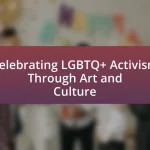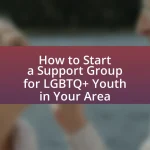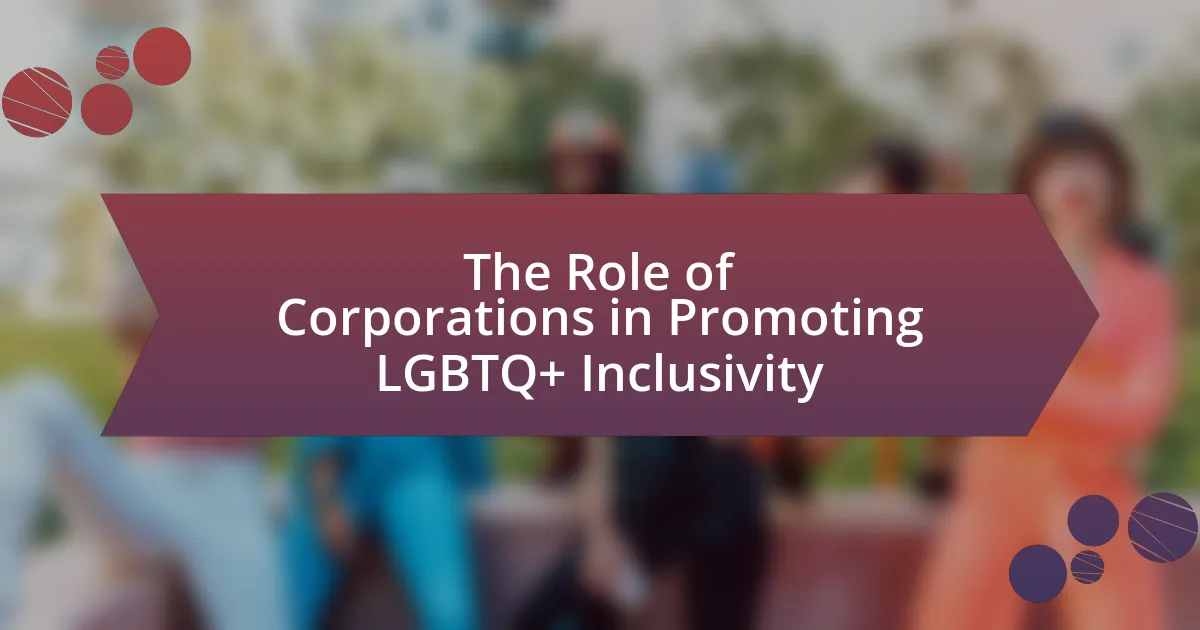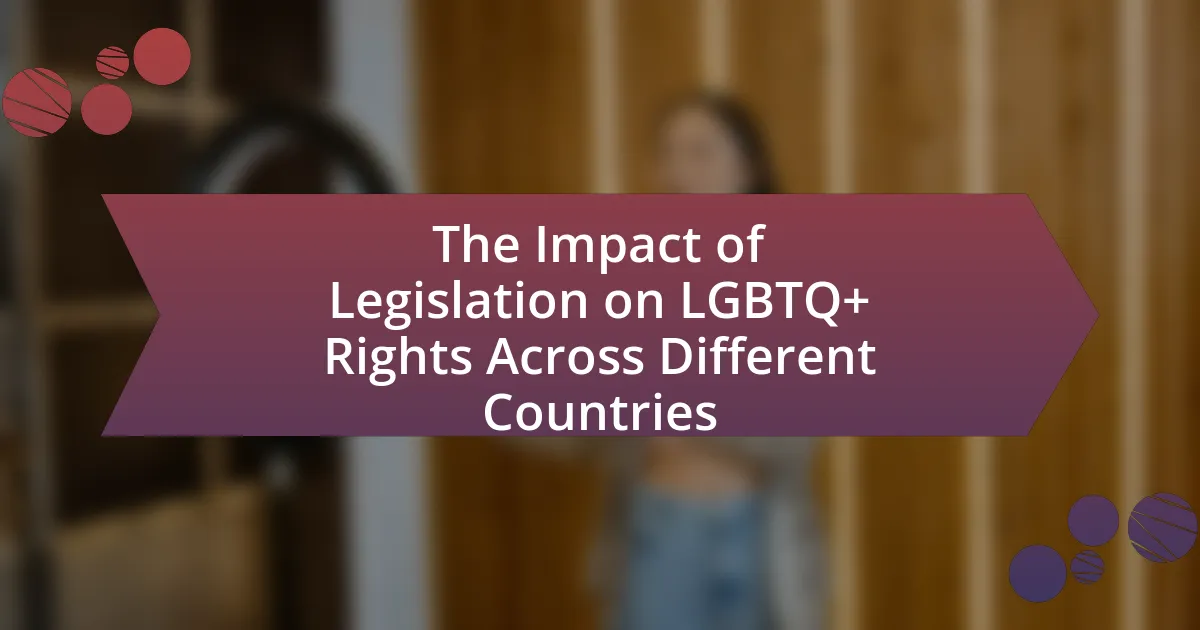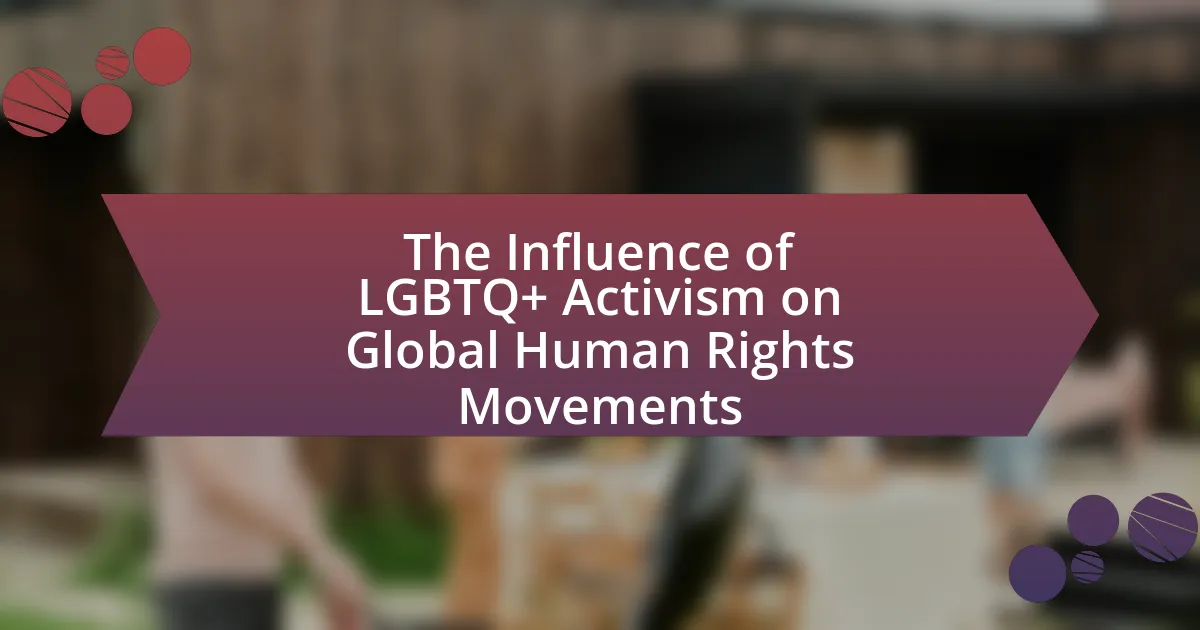The article examines the significant role of social media in amplifying LGBTQ+ voices, highlighting its function as a platform for expression, community building, and activism. It discusses how social media has transformed the landscape for LGBTQ+ communities by fostering visibility and connection, with platforms like Twitter, Instagram, and TikTok being particularly influential. The article also addresses the challenges LGBTQ+ individuals face online, including harassment and privacy concerns, while emphasizing the importance of representation and the impact of influencers in shaping public perception. Additionally, it outlines strategies for effective advocacy and the role of allies in supporting LGBTQ+ voices on social media.

What is the Role of Social Media in Amplifying LGBTQ+ Voices?
Social media plays a crucial role in amplifying LGBTQ+ voices by providing a platform for expression, community building, and activism. It enables individuals to share their stories, experiences, and challenges, fostering visibility and awareness of LGBTQ+ issues. According to a 2021 report by the Pew Research Center, 70% of LGBTQ+ adults in the U.S. use social media to connect with others who share similar identities, highlighting its importance in creating supportive networks. Additionally, social media campaigns, such as #LoveIsLove and #TransRightsAreHumanRights, have mobilized global support for LGBTQ+ rights, demonstrating the power of these platforms in driving social change and advocacy.
How has social media changed the landscape for LGBTQ+ communities?
Social media has significantly transformed the landscape for LGBTQ+ communities by providing platforms for visibility, connection, and activism. These platforms enable individuals to share their experiences, access resources, and build supportive networks, which were often limited in traditional media. For instance, a study by the Pew Research Center in 2021 found that 63% of LGBTQ+ adults reported that social media has been a positive force in their lives, helping them connect with others who share similar identities and experiences. Additionally, social media campaigns, such as the #LoveIsLove movement, have raised awareness and fostered acceptance, contributing to societal changes regarding LGBTQ+ rights.
What platforms are most influential in amplifying LGBTQ+ voices?
Social media platforms such as Twitter, Instagram, TikTok, and Facebook are most influential in amplifying LGBTQ+ voices. These platforms provide a space for LGBTQ+ individuals to share their stories, connect with communities, and advocate for rights. For instance, Twitter has been pivotal in mobilizing movements like #LoveIsLove and #TransRightsAreHumanRights, which have garnered millions of tweets and widespread visibility. Instagram allows for visual storytelling, enabling users to express their identities through art and personal narratives, while TikTok has emerged as a powerful tool for younger generations to share experiences and educate others about LGBTQ+ issues. Facebook groups and pages serve as vital support networks, fostering community and activism. Collectively, these platforms have transformed the landscape for LGBTQ+ representation and advocacy.
How do social media algorithms impact LGBTQ+ visibility?
Social media algorithms significantly impact LGBTQ+ visibility by determining which content is prioritized and seen by users. These algorithms often favor engagement metrics, which can lead to the amplification of popular LGBTQ+ voices while marginalizing less mainstream perspectives. For instance, a study by the Pew Research Center found that LGBTQ+ content that generates high engagement is more likely to be promoted, thus increasing visibility for those creators. Conversely, content that does not engage users may be suppressed, limiting the diversity of LGBTQ+ narratives that reach broader audiences. This dynamic can create an echo chamber effect, where only certain voices are heard, affecting the overall representation of the LGBTQ+ community on social media platforms.
Why is it important to amplify LGBTQ+ voices on social media?
Amplifying LGBTQ+ voices on social media is crucial for fostering visibility and representation. This visibility helps combat discrimination and stigma, as studies show that increased representation leads to greater acceptance and understanding within society. For instance, a 2020 report by GLAAD found that 80% of LGBTQ+ individuals feel more empowered when they see their identities represented in media. Furthermore, social media serves as a platform for community building, allowing LGBTQ+ individuals to connect, share experiences, and mobilize for rights and equality. This collective voice can influence public opinion and policy, as evidenced by the significant role social media played in the success of marriage equality movements globally.
What are the social implications of increased LGBTQ+ representation?
Increased LGBTQ+ representation leads to greater social acceptance and reduced stigma towards LGBTQ+ individuals. This representation fosters visibility, allowing diverse identities to be recognized and normalized within society. Research indicates that increased visibility correlates with improved mental health outcomes for LGBTQ+ individuals, as seen in a study published in the Journal of Homosexuality, which found that representation in media positively impacts self-esteem and reduces feelings of isolation among LGBTQ+ youth. Furthermore, increased representation can influence public policy and advocacy, as seen in the legalization of same-sex marriage in various countries, which was significantly supported by positive media portrayals of LGBTQ+ relationships.
How does social media serve as a tool for activism within LGBTQ+ communities?
Social media serves as a crucial tool for activism within LGBTQ+ communities by providing a platform for visibility, connection, and mobilization. It allows individuals to share personal stories, raise awareness about issues affecting the community, and organize events or campaigns. For instance, hashtags like #LoveIsLove and #TransRightsAreHumanRights have gained significant traction, facilitating global conversations and solidarity. Research indicates that social media campaigns can lead to increased public support for LGBTQ+ rights; a study by the Williams Institute found that social media engagement correlates with higher levels of acceptance and understanding of LGBTQ+ issues. Thus, social media not only amplifies LGBTQ+ voices but also fosters community solidarity and drives social change.

What challenges do LGBTQ+ individuals face on social media?
LGBTQ+ individuals face significant challenges on social media, including harassment, discrimination, and privacy concerns. These challenges manifest as targeted hate speech, cyberbullying, and doxxing, which can lead to emotional distress and mental health issues. According to a 2021 report by the Human Rights Campaign, 60% of LGBTQ+ youth reported feeling unsafe online due to their sexual orientation or gender identity. Additionally, the anonymity of social media can embolden individuals to engage in harmful behavior, further exacerbating the risks for LGBTQ+ users.
How do online harassment and discrimination affect LGBTQ+ voices?
Online harassment and discrimination significantly undermine LGBTQ+ voices by creating a hostile environment that discourages open expression and participation. This negative impact is evidenced by studies indicating that 73% of LGBTQ+ individuals have experienced online harassment, leading to increased mental health issues and a reluctance to engage in discussions about their identities. Furthermore, the fear of backlash often silences LGBTQ+ individuals, limiting their visibility and representation in social media platforms, which are crucial for advocacy and community building.
What measures can be taken to combat online hate against LGBTQ+ individuals?
To combat online hate against LGBTQ+ individuals, social media platforms must implement stricter content moderation policies. These policies should include clear definitions of hate speech, robust reporting mechanisms, and swift action against violators. Research indicates that platforms with comprehensive hate speech policies see a reduction in harmful content; for example, a study by the Anti-Defamation League found that platforms that actively enforce community guidelines experience a 30% decrease in reported hate incidents. Additionally, educational campaigns aimed at raising awareness about LGBTQ+ issues can foster empathy and understanding, further mitigating online hate.
How do privacy concerns impact LGBTQ+ individuals’ engagement on social media?
Privacy concerns significantly impact LGBTQ+ individuals’ engagement on social media by causing them to limit their online interactions and self-expression. Many LGBTQ+ individuals fear discrimination, harassment, or exposure of their identities, leading to cautious behavior such as using pseudonyms or restricting their audience. Research indicates that 70% of LGBTQ+ users have adjusted their privacy settings to protect their identities, reflecting a heightened awareness of potential risks associated with sharing personal information online. This cautious approach can hinder community building and the sharing of experiences, ultimately affecting the visibility and amplification of LGBTQ+ voices on these platforms.
What role do influencers play in amplifying LGBTQ+ voices?
Influencers play a crucial role in amplifying LGBTQ+ voices by leveraging their platforms to raise awareness, promote inclusivity, and foster community engagement. They often share personal stories and experiences that resonate with their followers, creating a sense of representation and visibility for LGBTQ+ individuals. For instance, studies show that 70% of LGBTQ+ youth feel more accepted when they see influencers openly discussing LGBTQ+ issues, highlighting the impact of visibility on mental health and community support. Additionally, influencers can mobilize their audiences for advocacy campaigns, such as Pride events or anti-discrimination initiatives, effectively driving social change and encouraging allyship.
How do LGBTQ+ influencers shape public perception and awareness?
LGBTQ+ influencers shape public perception and awareness by leveraging their platforms to promote visibility, representation, and advocacy for LGBTQ+ issues. Through social media, these influencers share personal stories, educate their audiences on LGBTQ+ rights, and challenge stereotypes, which fosters greater understanding and acceptance among diverse populations. For instance, a study by the Williams Institute found that increased visibility of LGBTQ+ individuals in media correlates with more favorable attitudes towards the community. Additionally, influencers often engage in campaigns that highlight social injustices, thereby mobilizing their followers to support equality initiatives, further enhancing public awareness and advocacy efforts.
What are the risks and rewards for influencers advocating for LGBTQ+ rights?
Influencers advocating for LGBTQ+ rights face both significant risks and substantial rewards. The risks include backlash from conservative audiences, potential loss of sponsorships, and threats to personal safety, as evidenced by incidents where influencers have received harassment or threats for their support. Conversely, the rewards encompass increased visibility for LGBTQ+ issues, the ability to foster community support, and enhanced brand loyalty from progressive audiences, as seen in campaigns that successfully engage with LGBTQ+ themes and resonate with inclusive values.

How can social media be used effectively to support LGBTQ+ advocacy?
Social media can be used effectively to support LGBTQ+ advocacy by creating awareness, fostering community engagement, and mobilizing action. Platforms like Twitter, Instagram, and Facebook allow advocates to share personal stories, educational content, and resources that highlight LGBTQ+ issues, thereby increasing visibility and understanding. For instance, campaigns such as #LoveIsLove and #TransRightsAreHumanRights have successfully raised awareness and garnered widespread support, demonstrating the power of social media in shaping public discourse. Additionally, social media facilitates real-time communication and organization of events, such as Pride marches and fundraising initiatives, which can lead to tangible support for LGBTQ+ rights. According to a 2020 report by the Pew Research Center, 70% of LGBTQ+ adults in the U.S. use social media to connect with others, indicating its critical role in community building and advocacy efforts.
What strategies can organizations use to amplify LGBTQ+ voices on social media?
Organizations can amplify LGBTQ+ voices on social media by implementing inclusive content strategies, engaging with LGBTQ+ communities, and collaborating with LGBTQ+ influencers. Inclusive content strategies involve creating and sharing posts that reflect the diversity of LGBTQ+ experiences, which can increase visibility and representation. Engaging with LGBTQ+ communities through interactive campaigns, such as Q&A sessions or live discussions, fosters a sense of belonging and encourages participation. Collaborating with LGBTQ+ influencers allows organizations to leverage established voices within the community, enhancing credibility and reach. Research indicates that brands that authentically engage with LGBTQ+ issues see a 30% increase in positive brand perception among LGBTQ+ consumers, demonstrating the effectiveness of these strategies.
How can storytelling be leveraged to enhance LGBTQ+ representation?
Storytelling can enhance LGBTQ+ representation by providing authentic narratives that reflect diverse experiences within the community. By sharing personal stories through various media platforms, individuals can challenge stereotypes, foster empathy, and create a sense of belonging. Research indicates that representation in storytelling leads to increased visibility and acceptance; for instance, a study by the Williams Institute found that positive portrayals of LGBTQ+ individuals in media correlate with greater societal acceptance and understanding. This demonstrates that storytelling not only amplifies LGBTQ+ voices but also contributes to broader cultural shifts towards inclusivity.
What role does community engagement play in successful LGBTQ+ campaigns?
Community engagement is crucial for the success of LGBTQ+ campaigns as it fosters inclusivity, builds trust, and amplifies diverse voices within the community. Engaging community members allows campaigns to tailor their messages to resonate with specific audiences, ensuring that the initiatives reflect the needs and concerns of LGBTQ+ individuals. For instance, campaigns that actively involve local LGBTQ+ organizations and activists often see higher participation rates and more effective outreach, as evidenced by the success of initiatives like the Human Rights Campaign’s “Equality Votes” campaign, which mobilized grassroots support through community involvement. This engagement not only enhances the credibility of the campaign but also creates a sense of ownership among community members, leading to sustained advocacy and support.
What best practices should individuals follow when advocating for LGBTQ+ rights online?
Individuals advocating for LGBTQ+ rights online should prioritize respectful communication, factual information sharing, and allyship. Respectful communication involves using inclusive language and acknowledging diverse identities within the LGBTQ+ community. Sharing factual information is crucial; individuals should verify sources and provide accurate data to counter misinformation, as studies show that misinformation can undermine advocacy efforts. Additionally, practicing allyship by amplifying marginalized voices and supporting LGBTQ+ organizations can strengthen the movement. For instance, a 2021 report by the Human Rights Campaign highlights that social media campaigns led by LGBTQ+ individuals have significantly increased visibility and support for LGBTQ+ rights.
How can allies effectively support LGBTQ+ voices on social media?
Allies can effectively support LGBTQ+ voices on social media by amplifying their messages, sharing their content, and engaging in conversations that promote understanding and acceptance. By retweeting or sharing posts from LGBTQ+ individuals and organizations, allies help increase visibility and reach, which is crucial given that 70% of LGBTQ+ youth report feeling isolated and unheard. Additionally, allies should actively challenge discriminatory comments and misinformation, fostering a supportive environment that encourages open dialogue. Research indicates that supportive online communities can significantly improve mental health outcomes for LGBTQ+ individuals, highlighting the importance of allyship in digital spaces.
What are the common pitfalls to avoid in LGBTQ+ advocacy on social media?
Common pitfalls to avoid in LGBTQ+ advocacy on social media include tokenism, lack of intersectionality, and spreading misinformation. Tokenism occurs when organizations or individuals superficially include LGBTQ+ voices without genuine engagement, which can undermine the authenticity of advocacy efforts. Lack of intersectionality fails to recognize the diverse experiences within the LGBTQ+ community, leading to advocacy that does not address the needs of marginalized subgroups, such as people of color or those with disabilities. Spreading misinformation can damage credibility and harm the community, as inaccurate information can perpetuate stereotypes and misconceptions. These pitfalls can hinder effective advocacy and diminish the impact of social media efforts in amplifying LGBTQ+ voices.

